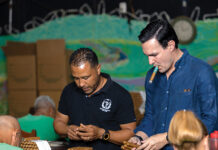Oriental Tobaccos: Oriental tobaccos come from countries in the northern and eastern Mediterranean regions—Greece, Cyprus, Turkey, the Balkans and Syria—and include Latakia. These tobaccos are famous for their fragrant aroma and are used as the major component in English blends.
The most well-known oriental tobacco is Latakia, which isn’t a tobacco in its own right but refers to a process that cures tobacco over fires burning fragrant woods such as cyprus, yew, pine or juniper. The tobacco absorbs the smoke, which gives it a distinct peppery and smoky flavor and aroma. Latakia originally came from Syria, but that source is no longer available. Cyprus provides most of today’s Latakia. Latakia is too strong to be smoked by itself so it is used as a condiment tobacco to add flavor to English blends.
Oriental tobaccos tend to smoke cooler than burley or Virginia tobaccos, and tobacconists can recommend blends based on Oriental tobaccos for customers complaining of tongue bite from smoking an aromatic blend or blends filled with sugary burleys and Virginias.
Perique: The name “perique” refers to a processing method used by Native Americans living in present-day Louisiana. (For a brief history of perique and how it is processed today, see “Perique: A Resurrection Story” in the January/February 2018 issue of Tobacco Business). Most often, burley undergoes the perique process, which produces a distinctive condimental tobacco that would be too strong to smoke on its own. Typically, perique is blended with Virginia tobaccos, and a little bit goes a long way.
Authentic perique tobacco is grown in St. James Parish, Louisiana, where it is also processed. For many years, perique processors blended perique with other tobaccos to supply the world’s market, but in recent years a very small supply of pure St. James Parish perique has become available. Kentucky Green River burley is also used to make perique.
Virginias
Despite their name, Virginia tobaccos are grown around the world, including North America, South America, Asia and Africa. The term rather describes the type of seed that’s used and the flue-curing process in which the tobacco is exposed to high heat inside the curing barn to produce a bright color and to lock in the natural sugars contained in the leaf. Slow-smoking a straight Virginia or a Virginia blend typically rewards a pipe smoker with a sweet and tangy flavor. Due to the high sugar content, straight Virginia pipe tobaccos age well in the tin, and some pipe tobacco enthusiasts enjoy collecting aged Virginia tobaccos.
Virginias are classified by color—bright, golden, red and lemon are the most commonly used descriptions—and, generally, the darker the color the lower the sugar content. Lighter Virginias tend to be spicy, while darker Virginias offer a deeper and more complex flavor. Pipe tobacco manufacturers sometimes stove Virginias, cooking them to speed up the fermenting process. Stoving produces darker tobacco and lowers the sugar content.
This story first appeared in the March/April 2018 issue of Tobacco Business magazine. Members of the tobacco industry are eligible for a complimentary subscription to our magazine. Click here for details.
– Story by Stephen A. Ross, senior editor of Tobacco Business Magazine







